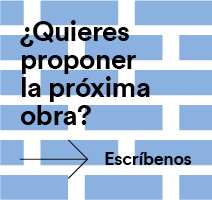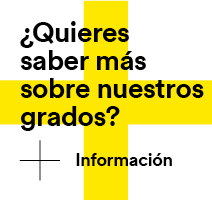Read
The Sanfermines poster
Reading posters is not the same as reading advertisements, let alone news or books.
news or books. However, it is about reading a story,
hearing its "shout on the wall" that catches our attention. This time,
of course, it is about the Sanfermines: an art form.
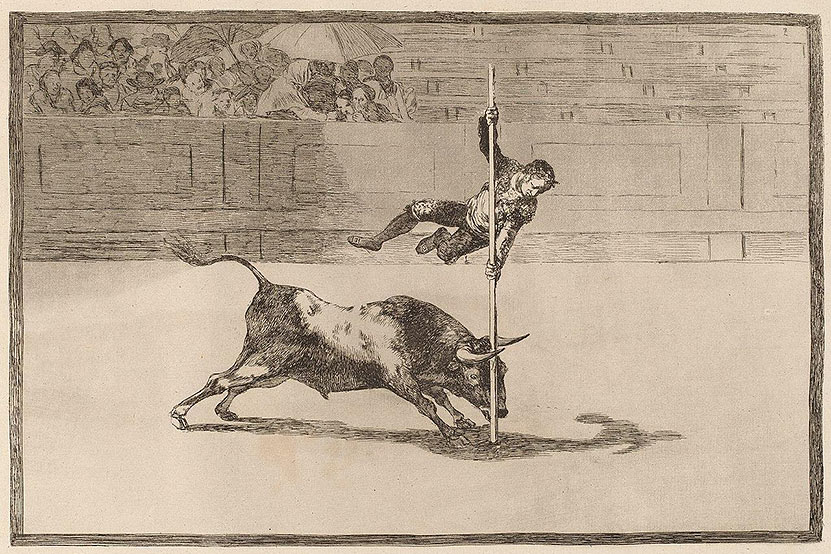
Francisco Goya, Lightness and daring of Juanito Apinani in the one in Madrid, 1816
The R.A.E. in its Dictionary of the Spanish language defines the poster as: Sheet of paper or other subject on which there are inscriptions or figures and which is exhibited for news purposes, for advertising, etc. We therefore understand the poster as a set of graphic elements: texts and images, printed on paper, the purpose of which is to inform about an event. It is a communication medium that aims to give maximum diffusion to what it advertises, with the simple means at its disposal: A printed paper, generally in a large format, to be placed in visible places, so that it can be seen by as many people as possible and at a greater distance. Its communicative capacity will depend as much on its technical and aesthetic quality as on its appropriate dissemination or placement.
Already in its definition we find aspects that place it close to that "shout on the wall" that is capable of attracting our attention in an urban jungle full of advertisements and visual stimuli that capture our senses and, for this very reason, distance it from what we usually understand as a work of art.
Characteristics of the poster
Origin: It always arises from a commission, from a promoter, who wishes to advertise, publicise or disseminate "his" information.
Purpose: It is a communication medium, intended to inform, at final advertise and disseminate what it advertises.
Public: It must be as broad as possible in order to fulfil the functional goal which is its reason for existence.
Reproducibility: It must be a work capable of multiplying easily as much as possible and of adapting to the different spaces where it can find that "niche" where it can be advertised.
Ubiquity and Adaptability: Hoy todo cartel que se precie, es decir que quiera tener la máxima difusión posible, debe se capaz de tener una buena adaptación para su reproducción en camisetas, pines y chapas, e infinidad de productos de merchandising.
Temporality: Eph emeral, it lasts as long as what it announces lasts.
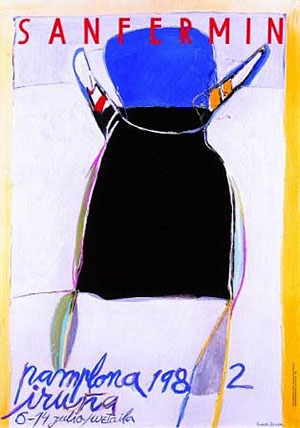 Posters that illuminate history
Posters that illuminate history
The history of poster art dates back to the 19th century, associated with the development lithographic printing press, and it was also at this time that the custom of announcing the Sanfermines with a poster began. This history provides knowledge from many different perspectives, ranging from ethnographic, sociological, historical, graphic and artistic.
As José Luis Molins says on the website of file Municipal de Pamplona, which has the largest collection of posters in existence,
"At first, in the first half of the 19th century, they were presented as one-colour leaflets,
simple advertising texts, some of which were illustrated with appropriate scenes. Later on, the creation of pictorial
The creation of pictorial, iconographic and colourful advertisements was contemplated later on...".
The posters provide a great deal of information about the history of the city, the customs, the costumes, the subject of events that were held or the duration of the fairs themselves.
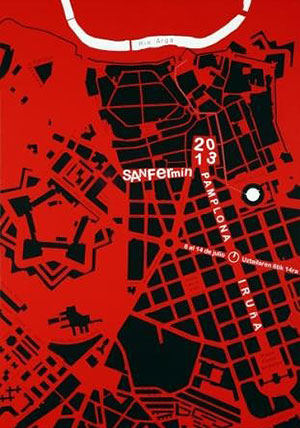 In terms of graphics and art, a look at the posters reveals how the various typographic and compositional fashions of the time were introduced, from the the chromatic tastes of each era and, above all, the influences of certain artistic trends. La historia del cartel de San Fermín (The history of the San Fermín poster), a very didactic and visual account of the evolution of the graphic design in Spain.
In terms of graphics and art, a look at the posters reveals how the various typographic and compositional fashions of the time were introduced, from the the chromatic tastes of each era and, above all, the influences of certain artistic trends. La historia del cartel de San Fermín (The history of the San Fermín poster), a very didactic and visual account of the evolution of the graphic design in Spain.
The poster, like the Sanfermines, has evolved and from its initial, fundamentally informative function, which filled the posters with texts during the second half of the 19th century and the early years of the 20th century, it evolved towards an artistic conception of the poster in the first decades of the 20th century with the rise of the modern poster and magazine illustration, the influence of art nouveau - and its desire to bring beauty to everyday life - and its coexistence with more costumbrista tendencies..... In 1964, the photographic-journalistic image burst onto the scene, which would be used throughout the 1970s, interrupted only by the innovative proposals of Mariano Sinués. From the 1980s onwards, a new way of understanding the poster began to take hold, with the incorporation of avant-garde plastic trends into the San Fermin iconography: from abstraction, conceptual art, pop art, graffiti, the new figuration and, together with them, new concepts and technical tools from the graphic design . These were the years of the "do you design or do you work?" and the appearance of design as something present in all facets of our lives. This new conception of the poster and its new functionality coincided with the irruption of television into our lives. In 1982, the televised running of the bulls began. In 1993 they were broadcast throughout Spain and today they are broadcast live all over the world. (Of course, the poster can no longer compete "propagandistically" with the real moving image that television brings into every home in the world).
Chair of Heritage and Art in Navarre, "The San Fermín poster today",
Mr. Javier Manzanos Garayoa, Director of the Huarte Contemporary Art Centre.
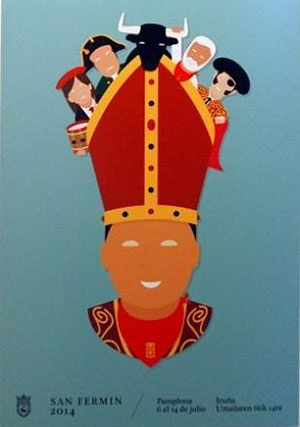 Image and iconography of San Fermín (excerpt)
Image and iconography of San Fermín (excerpt)
The extraordinary popularity of the Sanfermines and its international projection have multiplied the images of San Fermín in an incomparable way, giving it a diffusion that no other religious image has experienced, both in number and variety and, of course, in media, far beyond devotion and worship. See the example of the winning 2014 poster(Ignacio Domenech, Equipazo).
Thus, from the second half of the 20th century onwards, and accentuated in the years of the 21st century, together with the traditional representations, which have remained almost unchanged, we have witnessed a progressive trivialisation of the sacred image, which has been stripped of its character and often turned into a mere symbol or reference of the festivity. And together with this desacralisation, there has been a process of simplification of the image, which can be recognised, curiously enough, by the minimisation and simplification of the episcopal attributes: the mitre, the crozier and often the rain cape, which, through a curious popular interpretation of the well-known bust-reliquary that is taken out in Pamplona in procession on 7 July, has been interpreted as a bullfighter's cape.
Chair of Navarrese Heritage and Art,
"Image and iconography of San Fermín. From the martyr of Amiens to the posters of the Festivities",
D. Emilio Quintanilla Martínez.
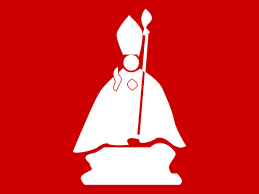
Other outstanding posters
(on loan from the Chair of Navarrese Art and Heritage):
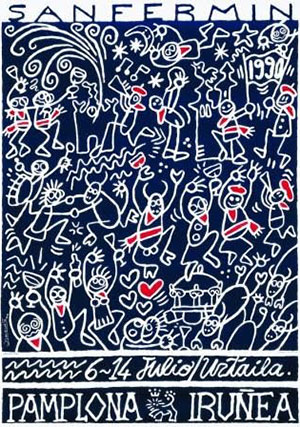
Winning poster 1990
Author: Mikel Urmeneta
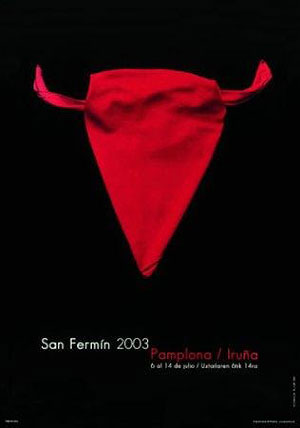
Winning poster 2003
Author: Pablo Nanclares
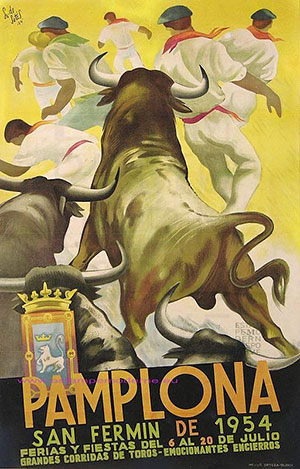
Paris, Galerie Estampe Moderne et Sportive (www.estampemoderne.eu), 1954
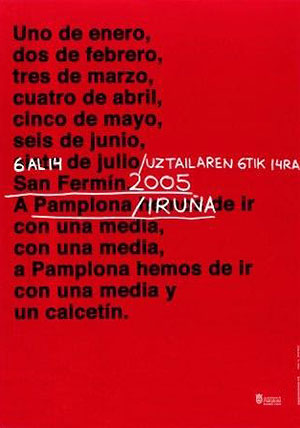
Winning poster 2005
Author: Gorka Aizpurúa
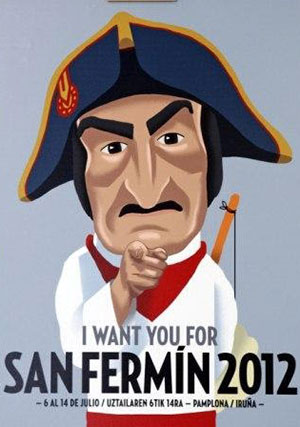
Winning poster 2012
Author: David Alegría

Winning oil painting of 1911
Author: Isidoro Calvete


